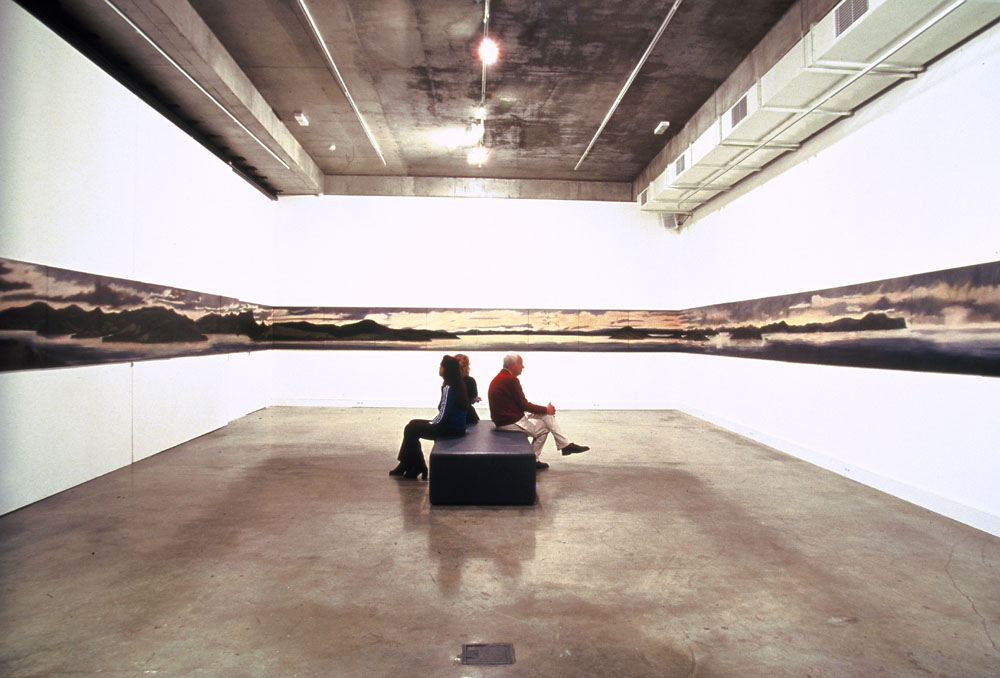 Faculty Gallery Monash University 2004
Faculty Gallery Monash University 2004
 Warrnambool Art Gallery 2003
Warrnambool Art Gallery 2003
 Warrnambool Art gallery
Warrnambool Art gallery
 Detail Storm Bay
Detail Storm Bay
What does painting do - irrespective of its styles?
It invites what isn't there to become present. 1 John Berger.
Circumnavigating the Island, in its entirety, is a 30-metre panoramic landscape painting that unfolds before the eye taking the viewer on a journey around the shoreline of North Bruny Island which lies off the southeast coast of Tasmania in Australia. The view surveys three distinct waterways: The D'Entrecasteaux Channel looking westward, the Derwent River in the north, and Storm Bay, which extends into the Southern Ocean off the eastern shoreline.
This panoramic installation is an experiential work in two ways. Firstly, in that it surrounds and involves the viewer in the illusion of a specific environment and terrain, allowing the eye to survey a large area and gain a sense of both being in and moving through space. The continuous multiple panels that wrap around the walls of the gallery represent the journey one would experience when walking around the northern tip of this Island.
As the viewer follows the panels, a secondary journey takes place. From the early light of dawn to the evening twilight which is synonymous with this southerly latitude of forty degrees south, the painting encompasses the passage of a day .Circumnavigating the Island is a place of dark, melancholic beauty, effectively capturing the brooding atmosphere, light and colour of this region.
For the past decade, Holt has spent prolonged periods of time painting en plein air in the Tasmanian landscape. Painting alone, exposed to the elements, is a concentrated and highly personal process. Holt's attachment to the landscape through her attentive engagement as an artist has, she says, helped shape her identity. Or put more precisely, 'How I place myself.' 2
Working in the natural environment, the artist forges a connection and a sense of belonging to the landscape. A synthesis of the cultural, natural, and personal worlds. Holt translates the experience to canvas. Somehow, through the soft hues of her palette and the slow glide of paint, we too gain a glimpse, a feeling of being there.
In Australia most people live in urban environments, yet it is the presence of the wilderness, the great unknown expanses, that still looms large in our imaginations. Landscape has an undeniable, archetypal presence in the Australian psyche - the deserts, the bush land and the vast coastline. The landscape is both feared and desired. It is inextricably bound to our identity, our sense of who we are, both as individuals and as a nation. This is particularly true in Tasmania where vast areas of wilderness still exist. For generations, artists in Australia have responded to the landscape not only for its unique and alluring aesthetic qualities, but also as a way of exploring personal, social, political and cultural connections to it.
Australia was founded on the displacement of two distinct groups: the indigenous inhabitants and the transported convicts from Britain. Two hundred years after Australia's colonization, the process of developing our cultural identity is ongoing. Reconnecting with the land and revisiting and reconciling our histories are a vital part of this process. The solitary but resounding word sorry at the conclusion of Circumnavigating the Island is an apology to the decedents of the traditional owners of Bruny, the Nuenonne, who called the island Lunnawannalonna.
Circumnavigating the Island is a potent lyrical journey through time and space.
The massive scale of this work positions the viewer on a precarious cusp. The work is at once both seductive and somewhat overwhelming. It mirrors the actual landscape in this way. As we stand before waterways, sloping hills, changing skies, color and light, the continuous horizon envelops the viewer in a strong sense of place. And, we are silenced by its reflective grandeur.
In 1927 the Australian artist Margaret Preston wrote that 'art is the tangible spirit of a country'3 There is a sublime, haunting quality, a depth to this work, which resists words. For, ultimately, Circumnavigating the Island is a poem of place.
Bronwyn Scanlon 2006
Bronwyn Scanlon is a Melbourne based writer and published author, who has resided on Bruny Island for an extended period.
1 John Berger, Preface in I Could Read the Sky, Steve Pyke and Timothy O'Grady. (London: The Harvill Press 1997)
2 Ann Holt, cited in Bronwyn Scanlon, Catalogue essay, Caught Looking - Identity and Self-Portraiture, Melbourne 1998 p5
3 Margaret Preston cited in Deborah Edwards, Margaret Preston, ( Sydney ,Art Gallery New South Wales, 2005)
Ann Holt is a Lecturer in the Faculty of Art and Design at Monash University in Melbourne Australia. She spends extensive periods living and painting on Bruny Island, Tasmania. Her painting practice is concerned with making a contemporary response to the landscape, in reference to historical traditions, insights into the language of this genre, connection to place and notions of the sublime. During the past ten years she has exhibited extensively in both solo and group exhibitions. Her work is held in collections in Australia and the United States.
The artist would like to acknowledge and thank the principle sponsor for this exhibition
The Dame Elizabeth Murdoch Trust Fund. Also for additional assistance from the
Faculty of Art and Design, Monash University. The artist would also like to thank the Australian Ambassador to Denmark Matthew Peek, , Dr. Robert Nelson Associate Dean of Research Faculty Art and Design Monash University, Scanlan & Theodore, Christine Abrahams Gallery Melbourne, Despard Gallery Hobart, Selina Lightfoot, Peter Rose, John Corker, Bronwyn Scanlon and the Australian Business Arts Foundation